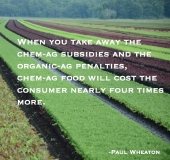
 3
3




Community Building 2.0: ask me about drL, the rotational-mob-grazing format for human interactions.









Community Building 2.0: ask me about drL, the rotational-mob-grazing format for human interactions.
 4
4




Idle dreamer
 1
1




 2
2




 2
2




Phil Stevens wrote:
If you're looking at removal of carbon from the cycle, you will need to pyrolyse that corn. Or hemp, switchgrass, miscanthus, or whatever you grew.









Phil Stevens wrote:Remember that "sequestration" in a carbon crop is only as good as the means of storage. If you're just putting it back into the soil, most of the carbon will be back in the atmosphere in a couple of years. This is not a bad thing in itself, as carbon is vital to soil health and it's all part of the biological cycle. But it's a flow and not a stock. You have to add a similar amount every year to keep soil C levels up, and the amount that is converted to humus is comparatively tiny.
If you're looking at removal of carbon from the cycle, you will need to pyrolyse that corn. Or hemp, switchgrass, miscanthus, or whatever you grew.
Community Building 2.0: ask me about drL, the rotational-mob-grazing format for human interactions.









Travis Johnson wrote:I wish there was a corn subsidy this year as I would have actually gotten it, and the ethanol subsidy was phased out several years ago.
I do not think corn is the evil crop that most people believe it to be though, and was a staple of the pioneers that came to Maine for a lot of good reasons. Those poor saps ate the stuff 3 meals a day, but back then, it really made sense due to how it grows, and where they were planting.
Community Building 2.0: ask me about drL, the rotational-mob-grazing format for human interactions.





 1
1




Tyler Ludens wrote:Corn doesn't grow all that well in the desert. There are other grasses which are better adapted.
For semi-arid areas I like prairie grasses such as Switchgrass. Also these don't need to be planted each year, being perennials.
I can grow Switchgrass without irrigation or protection from deer. I can't grow corn that way.
Community Building 2.0: ask me about drL, the rotational-mob-grazing format for human interactions.
















 1
1




Phil Stevens wrote:Hey Joshua -
Drying the seed and storing it would be an okay sequestration vehicle...as long as the storage was effective. But as soon as something eats the corn (you, mice, bugs, fungi) the carbon gets metabolised and it's back into the loop. Pyrolysis is the only low-tech means we have of removing the carbon from the biological cycle.
Community Building 2.0: ask me about drL, the rotational-mob-grazing format for human interactions.









paul salvaterra wrote:What is PO Corn?
Paul
Community Building 2.0: ask me about drL, the rotational-mob-grazing format for human interactions.
 2
2




Phil Stevens wrote:Remember that "sequestration" in a carbon crop is only as good as the means of storage. If you're just putting it back into the soil, most of the carbon will be back in the atmosphere in a couple of years.
Idle dreamer







 3
3








Tyler Ludens wrote:Corn doesn't grow all that well in the desert. There are other grasses which are better adapted.
For semi-arid areas I like prairie grasses such as Switchgrass. Also these don't need to be planted each year, being perennials.
I can grow Switchgrass without irrigation or protection from deer. I can't grow corn that way.
Life on a farm is a school of patience; you can't hurry the crops or make an ox in two days.
Henri Alain
 2
2




Phil Stevens wrote:Much of the carbon in prairie soils is bound up in living or recently dead stuff, which is why breaking sod and turning it over is so destructive. But there is a lot of black (pyrogenic) carbon in those soils from thousands of years of fire, first from lightning and then managed by First Peoples, which does not go away quickly even when exposed.
Idle dreamer





Some places need to be wild

|
I'm all tasted up for a BLT! This tiny ad wants a monte cristo!
Play Your Way to a Sustainable Lifestyle: Uncover Permaculture Principles with Each Card
https://gardener-gift.com/
|






